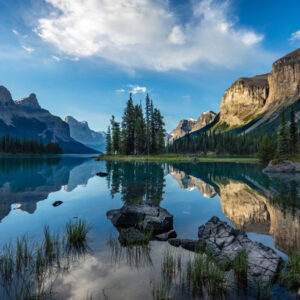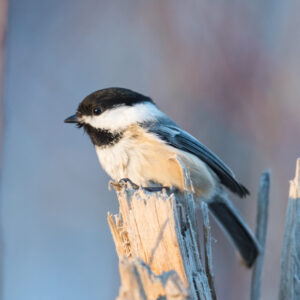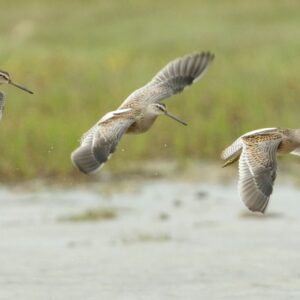Happy World Whale Day, Canada!
Thank you to our Nature Network partner, Saturna Island Marine Research & Education Society (SIMRES), for sharing this informative blog.
Whales of the Salish Sea
The Salish Sea, nestled in the inland waters of the Pacific Northwest, is a marine ecosystem rich in biodiversity. Its name recognizes the Indigenous peoples from more than 40 First Nations who speak the many different Coast Salish languages and were the first to live in and care for the area. It spans the inland waters south of Campbell River between Vancouver Island and the mainland of British Columbia, to Puget Sound in the State of Washington.
The Salish Sea is home to both toothed and baleen whales. Toothed whales, which include dolphins and porpoises, have teeth and actively hunt prey. They are capable of echolocating, which is the ability to use sound and vibrations to navigate and locate food. Baleen whales cannot echolocate and have plates in their mouth which filter food as they take in water to feed. These plates are made of the same protein that makes human hair.
Killer whales (also called orcas) are the prominent residents of the Salish Sea. There are two different ecotypes of killer whales in the Salish Sea: Bigg’s (also called Transients) and Residents. While different ecotypes of killer whales are the same species, they do not socialize or breed together, have different diets, and can look quite different to a trained eye. Resident killer whales eat fish and live in large familial groups called pods, while Bigg’s killer whales predominantly prey on other marine mammals and often reside in smaller groups. The two distinct populations of Resident killer whales in the Salish Sea are the Northern Residents and the Southern Residents.
Humpback whales are the most frequent baleen whales spotted in the Salish Sea and will visit the area during their migration routes between their summer feeding grounds in the north and their winter birthing grounds in the south. Grey whales will occasionally come into the Salish Sea during their migration routes, though not as commonly as the humpbacks. Some common minke whales spend their summers in the Salish Sea, often near the San Juan Islands.
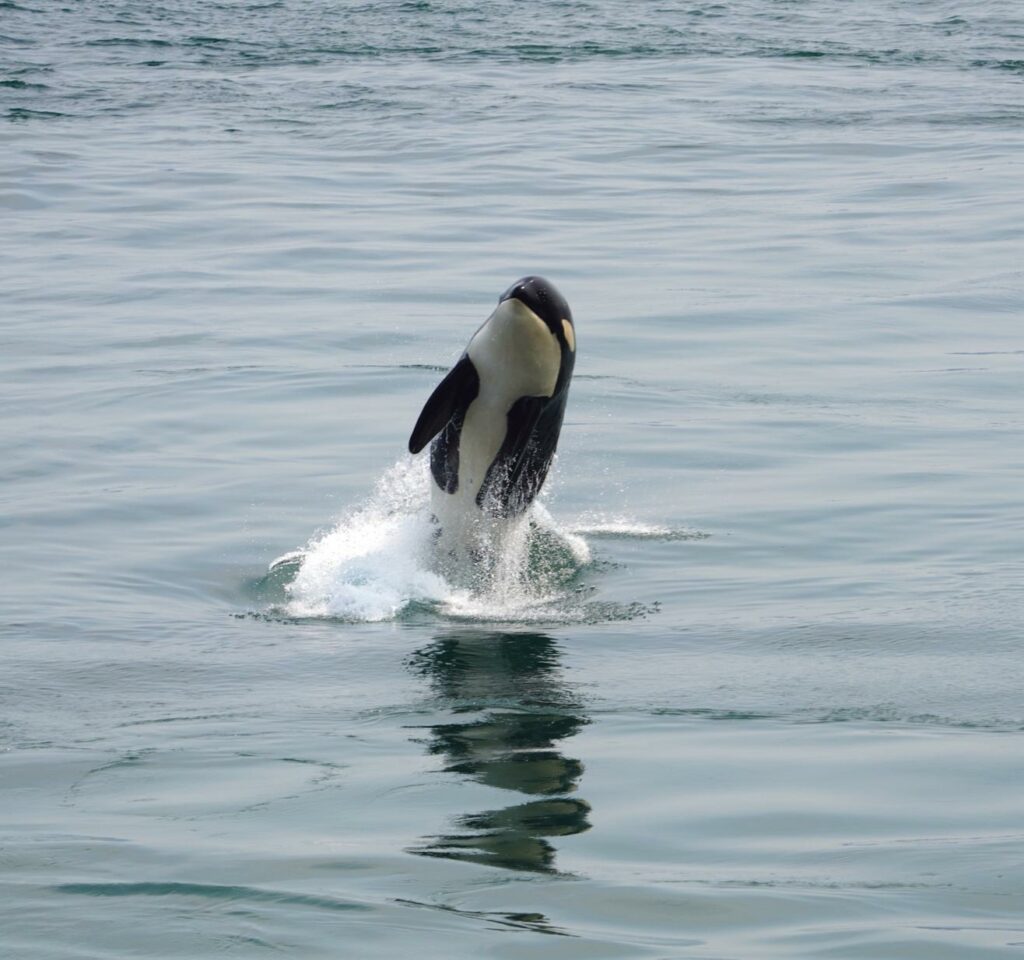
Southern Resident killer whale breaching off the coast of Saturna Island. Photo Credit: Lauren Laturnus.
Conservation Status
In the 1960s and 70s, many killer whales were captured for display in marine parks, causing harm to individual whales and wild populations. The Southern Resident killer whale population suffered tremendous loss and declined to only 71 individuals. Although the population increased briefly, peaking at 98 individuals in the mid-90s, it rapidly and severely declined again to 78 individuals by 2001. As of July 2023, there were 75 Southern Resident killer whales, and they are listed as Endangered in Canada. Northern Residents, while also impacted by captures and prey decline, have experienced a slow increase in population size since the 1970s and are currently listed as Threatened. Capturing or breeding whales is now illegal in Canada.
The population of Bigg’s killer whales and their presence in the Salish Sea has increased in recent years. This is likely due to the recovery of their prey species, particularly the harbour seal which began to recover after hunting regulations were implemented in the 1970s. Despite the recent increase, Bigg’s killer whales are still listed as Threatened under the Species at Risk Act (SARA) and their population is not considered stable.
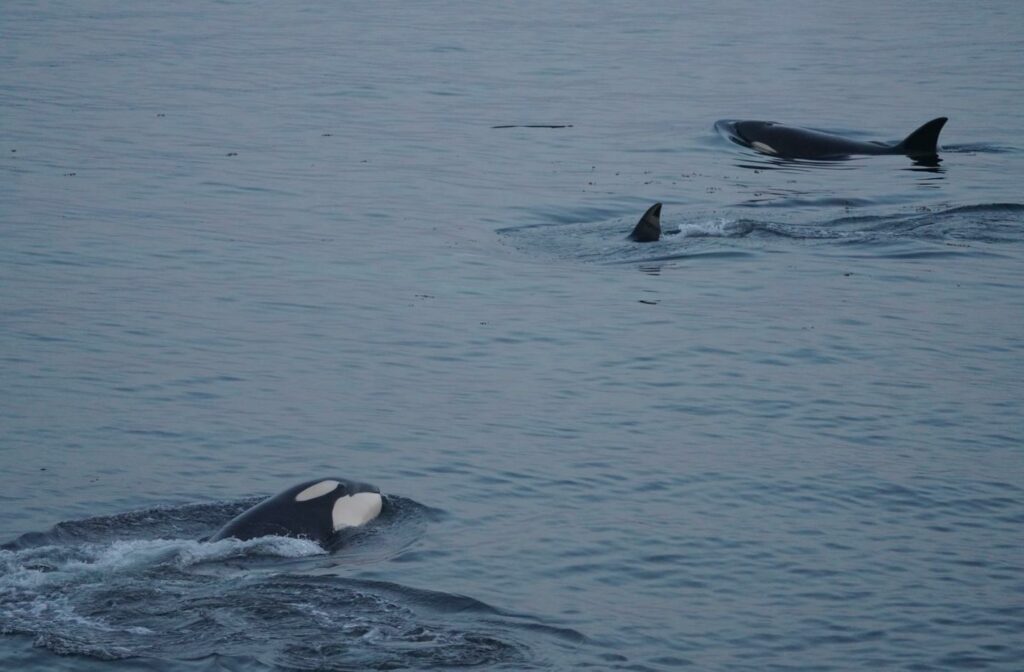
Bigg’s killer whales in the Saturna Island Interim Sanctuary Zone. Photo Credit: Mikayla Young
In the past, commercial whaling posed a threat to baleen whales like humpback and grey whales for centuries. However, after commercial whaling was halted in 1966, many of their populations began to recover. While humpbacks have made a noticeable return to the Salish Sea since the late 2000s, the North Pacific population is listed as a Species of Special Concern in Canada. Common minke whales and the Northern Pacific migratory population of grey whales are currently deemed not at risk.
Hazards for Whales in the Salish Sea
One may wonder why killer whales and humpbacks are still listed as Species at Risk even though capture for entertainment and commercial whaling is now illegal. The main contributors to their decline are prey availability (food), noise and physical vessel disturbance, as well as environmental contaminants.
What do these whales eat? Chinook salmon are the key prey species for Northern and Southern Resident killer whales, and their survival is closely linked with the abundance of Chinook which declined sharply in the mid-90s and has remained low ever since. To make matters worse, the southern part of the Salish Sea is one of the busiest shipping routes in the world. The marine traffic here also includes recreational boaters who enjoy the magnificent beauty of the region. The total number of vessels produces a lot of underwater noise! This makes it increasingly difficult, especially for the Southern Resident killer whales, to find their prey due to the noise from vessels interfering with their ability to echolocate and communicate with each other.
Additionally, vessels pose a physical threat to whales as collisions with them often result in serious injury or death. This is particularly concerning for baleen whales, as they cannot echolocate and may be less aware of vessel presence around them. The presence of vessels has also been observed to affect whale behaviour, such as decreasing the amount of time spent foraging and beach-rubbing, a unique behaviour of the Northern Residents.
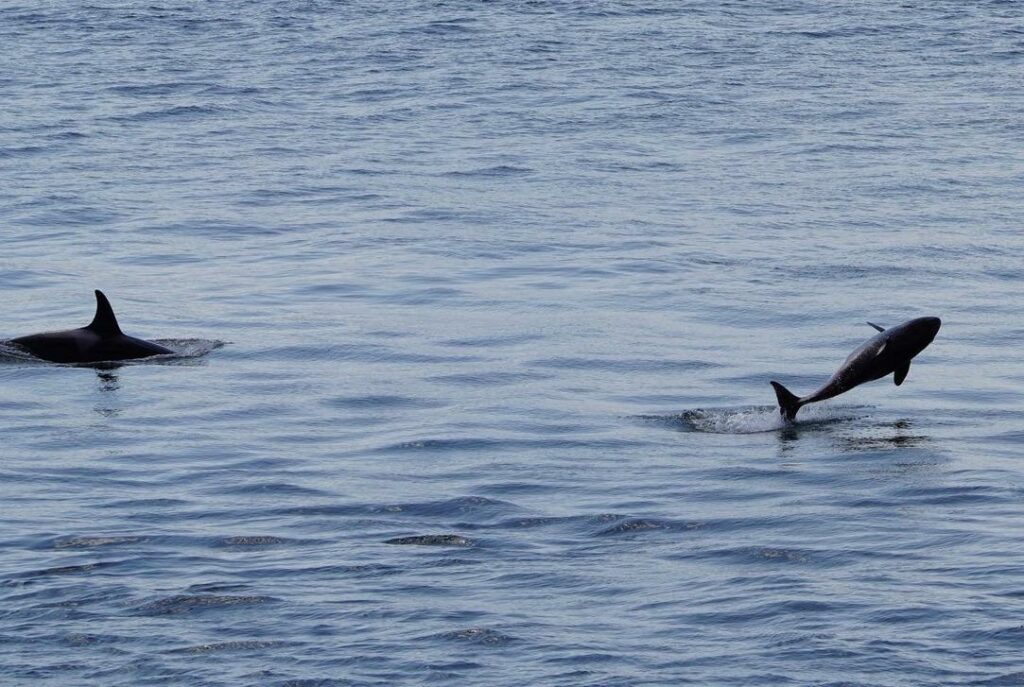
Southern Resident killer whale calf born in 2022 known as J59 or Sxwyeqólh (pronounced Swee-a-kosh) breaching out of the water ahead of her mother J37 or Hy’Shqa (pronounced HY-shka) in June 2023. Photo credit: Rachel Fairfield Checko
Working Together to Save the Whales
To support the recovery of Southern Resident killer whales, the Canadian government implemented management measures, including fishing restrictions and vessel traffic regulations. One measure designed to address vessel impacts was establishing two Interim Sanctuary Zones (ISZ) located off Pender Island and Saturna Islands. Since 2019, they have been in effect from June 1st to November 30th. Vessels are prohibited from travelling or fishing within these areas, with very limited exceptions. These areas were chosen due to their historical significance as important foraging grounds for the Southern Resident killer whales.
In 2012, a group of residents from Saturna Island who were concerned about the health of the marine ecosystem in the Salish Sea came together to form the Saturna Island Marine Research and Education Society (SIMRES). Today, they are a successful non-profit organization and have sponsored the Southern Gulf Islands Whale Sightings Network (SGIWSN), a citizen-led organization with trained volunteers from Saturna, Pender, Mayne, and Galiano Islands who collect data on whales and monitor vessels in the ISZs.
The Saturna ISZ runs along the coast of East Point, a popular island destination in the Gulf Island National Park Reserve and one of the best places in the world to watch whales from shore. The shore has remarkable depth, enabling whales to approach very close to land. The ISZ and surrounding waters also serve as a crucial ecosystem for Bigg’s killer whales and humpback whales, which frequently travel and forage within it. On occasion, a minke or grey whale has also paid a visit to East Point to say hello. Not surprisingly, East Point is a great place for research and the Saturna ISZ is one of the few places in the Salish Sea where there are different methods – both automatic and manual – used to detect whales and vessels.
Research is indeed happening! Since 2020 master’s students in the lab of Dr. Ruth Joy at Simon Fraser University (SFU) have collaborated with SIMRES and SGIWSN to conduct research and monitor the Saturna Island ISZ which has a good view of Boundary Pass, the Southern Strait of Georgia, and a large portion of the ISZ. These students have contributed to a greater understanding of whales and vessels in Boundary Pass, including how COVID-19 affected the underwater soundscape, the efficacy of management measures, drivers of humpback whale movement, and how shipping vessels affect the acoustic behaviour of Southern Resident killer whales.
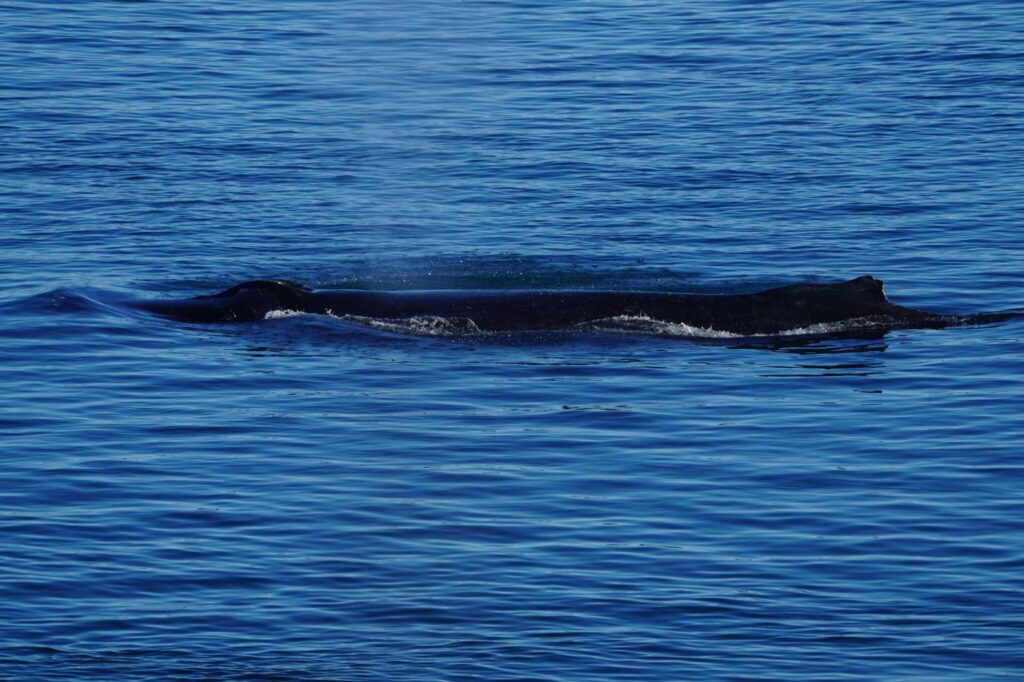
Humpback whale BCX1658 Bullet off the coast of Saturna Island. Photo credit: Lauren Laturnus
Dr. Joy has also recently developed a collaborative relationship between her laboratory and the QENTOL, YEN (W̱SÁNEĆ Marine Guardians). This partnership focuses on the implementation of Indigenous science to improve restoration initiatives for whales with anticipation that the Government of Canada will begin to recognize the importance of Indigenous science.
I am one of Dr. Joy’s master’s students and I had a front-row seat looking at whales last summer! My research looks at the different methods, both manual and automatic, for monitoring whales and vessels, and how they can be used to improve whale restoration initiatives. With help from my research partner, Rachel, and other members of Dr. Joy’s lab, I tracked whales and vessels using a device called a theodolite. When calibrated and used correctly, a theodolite can provide a reliable coordinate of the whale or vessel and place it on a map. Vessels in the ISZ were reported to authorities, and all whales were reported to the Whale Report app run by Ocean Wise.
Another detection method I am reviewing is the Southern Gulf Islands Whale Sighting Network, the citizen-science monitoring program, sponsored by SIMRES. Thanks to the fundraising for equipment and ongoing training, these dedicated volunteers have equipment and knowledge that enables them to make accurate reports of whales and vessels that illegally fish or travel in the ISZ. Their reports contribute to the understanding of whale activity in the area and greatly assist with the enforcement of the ISZ.
As for automated detection systems, SIMRES operates hydrophones (underwater microphones) in and near the ISZ. The audio recordings can be used to identify the presence of different species, ecotypes, and pods. Fisheries and Oceans Canada, in partnership with SIMRES, employs two thermal cameras that can detect the heat emitted from a whale when they surface, and a radar camera for tracking vessels. Yet another technical method is that some vessels are required to have an Automatic Identification System (AIS) that tracks their location, and some choose to do so voluntarily. When these vessels’ locations are detected within the ISZ, they are automatically reported.
A question often asked is: what is the best way to monitor whales? There isn’t one method of monitoring that outshines the rest, nor is there a single organization that has all the solutions. When it comes to whale research, it’s about the power of collaboration, especially because Canada set a goal to conserve 30% of our oceans by 2030.
Nature Canada, with other environmental groups, has identified the Southern Strait of Georgia as a priority marine area needing protection as part of the pathway to achieving 30×30. Partnerships with First Nations and organizations such as SIMRES help provide data on this important and threatened marine ecosystem. From my perspective, when we all work together to protect the marine ecosystem, the future survival of these whales becomes a bit brighter.
To learn more about SIMRES’ research in the Salish Sea, access the incredible SGIWSN whale sightings database or listen to one of SIMRES hydrophones live, visit simres.ca.
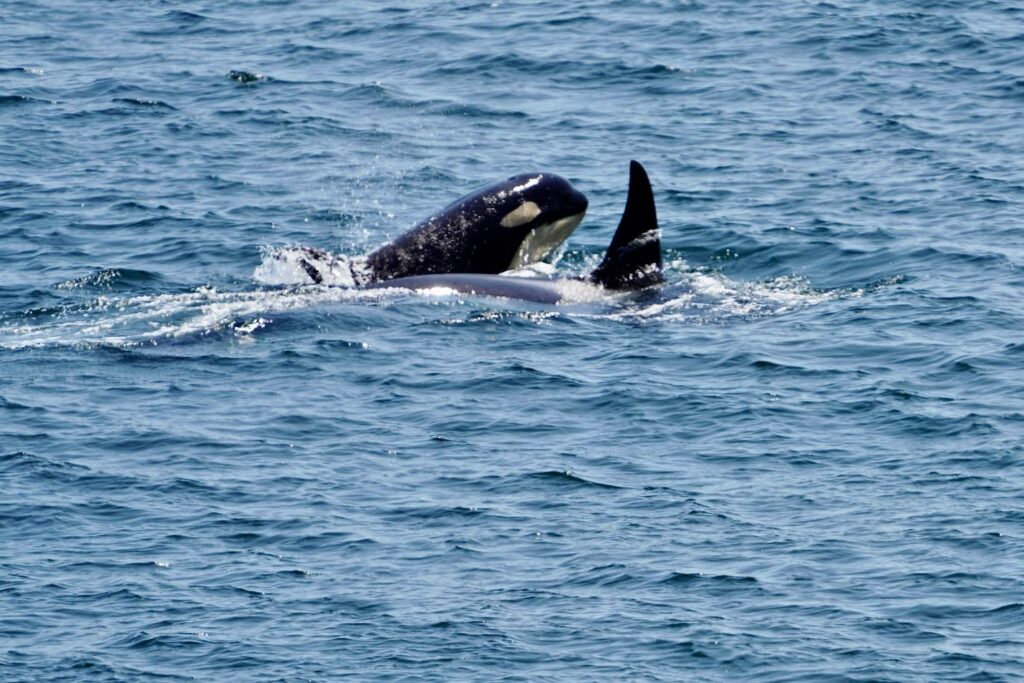
One of the two calves born in L-pod of the Southern Resident killer whales in 2023 swimming closely to an adult killer whale, likely its mother. Photo credit: Rachel Fairfield Checko
Tell the federal government to halt and reverse biodiversity loss by 2030 and fully recover nature by 2050 with a National Biodiversity Strategy backed by science, Indigenous knowledge, and an all-of-government approach.
Tell the federal government your priority is a National Biodiversity Strategy that protects species and communities alike:

